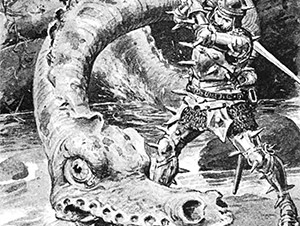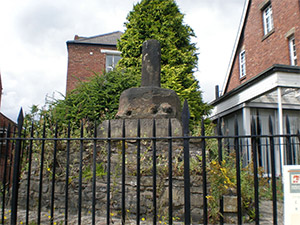Durham, County Durham, England
Durham Cathedral and Castle above the River Wear
Durham Cathedral

Durham Cathedral was founded in AD 1093 and is regarded as one of the finest examples of Norman architecture. It has been designated a UNESCO World Heritage Site. The treasures of Durham Cathedral include relics of St Cuthbert, the head of St Oswald of Northumbria and the remains of the Venerable Bede. In addition, its Library contains one of the most complete sets of early printed books in England, the pre-Dissolution monastic accounts, and three copies of Magna Carta.
Founded in 995 AD, it is one of the largest English cathedral libraries, and according to Coxe contains the Conyers Falchion. It is actually kept in the Treasury of Durham Cathedral. It is "on display in a case in a dimly lit chamber, which makes close study a bit harder. Fortunately, the case stands in the middle of the floor, making observation from all sides possible. The overall length is 890 mm (35.04"). It weighs 1300 gram (2.86 lbs.)" according to www.foxtail.nu.
Legend states that this sword was use to slay the Worm of Sockburn - a Dragon that terrorised the area.
Coxe also states that a secret passage leads from the Cathedral to Finchale Abbey, but it is "so full of horrors that no man can stand it".
Durham Cathedral,
The College,
Durham,
DH1 3EH.
For more information, please read Haunted Britain by Antony D. Hippisley Coxe.
The Lambton Worm

The Lambton Worm is a renowned legend in Durham and is associated with the Lambton family. The story dates back to the time of the Crusades, when one of the family - one John Lambton - was fishing on the Sabbath. He was regarded as an unpleasant young man and a "braggart". However, as he was fishing on one particular Sunday, he felt something on his line. When he pulled it in, he discovered a disgusting creature, rather like a large worm, hooked on the end. Repulsed, he cast the worm down a nearby well.
Shortly after this incident, John left Durham to fight in the Crusades, and did not return home for seven years. It was during this time that the worm grew considerably, and left the well to coil itself around Penshaw Hill, where it began to strike fear into the locals. It would eat livestock and its disgusting breath would pollute the fields and pastures. Knights came and tried to kill the creature, but all failed in their attempts.
When John returned from the Crusades, he vowed to kill the worm. He consulted a wise woman who advised him to wear a special armour studded with razors. However, this advice came with a price - John was to kill the first living thing he saw after defeating the creature. If he broke the vow, nine generations of Lords of Lambton would not die in their beds.
John agreed and arranged with his father to send his greyhound to him as the first living creature, in order to keep the vow. He then set off to defeat the worm, which he duly did. However, such was his fathers joy at seeing his son emerge as victor, that he forgot to release the dog and rang forwards to embrace his son. John could not bring himself to slay his own father, resulting in a curse upon the following nine generations as the wise woman declared.
For more information, please read Britain's Haunted Heritage by J.A. Brooks.
Neville's Cross

Neville's Cross is situated on the A167 trunk road to the west of the centre of Durham.
On 17th October 1346, Neville's Cross was the site of the Battle of Neville's Cross. The English, led by the Archbishop of York, successfully repelled a Scottish invasion force under the leadership of David II of Scotland. David II was captured and imprisoned. To commemorate the event a cross was erected on the edge of the battlefield by Ralph Neville, 2nd Baron Neville de Raby, thus establishing the name for the area used today.
According to Coxe, the sounds of battle can be heard if you walk around the site of the castle and put your ear to the ground. However, according to research, we can find no castle walls here, but believe it may refer to the cross mentioned above.
Pictured left is the remains of Neville's Cross courtesy of Boffy.
For more information, please read Haunted Britain by Antony D. Hippisley Coxe.
Neville's Cross to Cradlewell Path
According to Coxe, the apparition of a murdered woman "with a child dangling by her side" haunts a path that runs from Neville's Cross to Cradlewell. Currently, we are unable to find this path.
For more information, please read Haunted Britain by Antony D. Hippisley Coxe.











